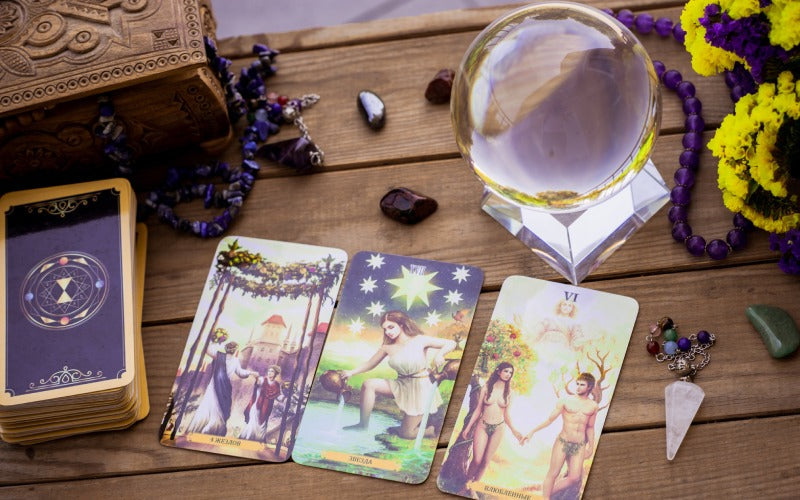On all Canadian Orders over $100 before taxes

Unlocking the Mystique of Tarot Cards
Unlocking the Mystique of Tarot Cards 🔮
Have you ever wondered about the fascination and mystique that surrounds tarot cards? How is it that these 78 uniquely designed cards seem to offer profound insights into our lives, guiding us through uncertainty and complex decisions? Tarot decks are much more than just a collection of beautifully illustrated images—they are an extraordinary blend of art, symbolism, and intuition that can illuminate our paths and offer meaningful guidance. Each card tells a story, and when combined, they create a rich tapestry of messages tailored to the individual. From the passionate energy of the suit of Wands, which represents creativity and ambition, to the Major Arcana cards that reflect significant life events and spiritual lessons, tarot invites you to engage in a deeply personal experience that resonates uniquely with you.
Understanding Tarot Cards 🃏
At first glance, a tarot deck might seem overwhelming with its 78 cards, but it’s helpful to know that these cards are organized into two main groups: the Major Arcana and the Minor Arcana. The Major Arcana consists of 22 powerful cards, including iconic figures like The Fool, The Magician, and The High Priestess. These cards represent key life moments, spiritual growth, and universal archetypes that many people can relate to. The remaining 56 cards make up the Minor Arcana, which is divided into four suits: Wands, Cups, Swords, and Pentacles. Each suit has its own focus—Wands symbolize creativity and action, Cups represent emotions and relationships, Swords correspond to intellect and conflict, and Pentacles relate to material wealth and the physical world. One of the fascinating aspects of tarot is its fluidity; the meaning of any given card can change depending on the question asked, the context of the reading, and your intuitive connection with the card at that moment.
A Brief History of Tarot ⏳
Tarot cards have a rich history that dates back to the 15th century, when they were originally used as playing cards. It wasn’t until the late 1700s that tarot began to be used for divination, thanks largely to figures like Jean-Baptiste Alliette who assigned mystical meanings to the cards. The Rider-Waite-Smith deck, published in 1910, was a major milestone in tarot history. Illustrated by Pamela Colman Smith and developed by A.E. Waite, this deck introduced detailed imagery to all 78 cards, making them more accessible and easier to interpret. Over the centuries, tarot decks have evolved and multiplied, reflecting diverse cultures, artistic styles, and spiritual perspectives. Today, you can find decks that range from classic and traditional to highly contemporary and themed, each inviting you to explore the cards in your own unique way.
How Tarot Works: Intuition and Synchronicity ✨
Understanding how tarot works is crucial to getting the most out of your readings. Tarot is not about predicting exact futures or fixed outcomes; rather, it is a tool for reflection, insight, and guidance. The heart of tarot reading lies in intuition. When you draw cards, your subconscious mind and feelings interact with the imagery and symbolism, allowing you to connect deeply with the messages the cards hold for you. French clergyman Antoine Court de Gébelin famously suggested tarot had ancient Egyptian and mystical origins, linking the cards to universal spiritual truths and virtues. Modern readers continue to value the intuitive process, knowing that each card’s meaning is personalized by your thoughts, emotions, and circumstances.
Another key concept is synchronicity, a term coined by psychologist Carl Jung. It refers to meaningful coincidences that seem too connected to be random. In tarot, this means the cards you draw are never by chance; they align with your current situation or the questions you bring to the deck. This is why, during a reading, the cards seem to “speak” directly to your life, providing guidance, clarity, and even comfort.
Conducting a Tarot Reading 🧙♀️
Performing a tarot reading involves more than just shuffling and laying out cards—it’s about creating a bridge between your inner wisdom and universal consciousness. Each card you pull contains rich symbols and meanings that speak to different facets of your life. For example, the suit of Cups often relates to feelings and relationships, while Swords focus on challenges and intellectual pursuits. The interpretation depends heavily on the context of the reading and the card’s position in the spread.
Popular tarot spreads help organize these messages. The three-card spread is one of the simplest yet most insightful layouts, offering perspectives on the past, present, and future of a situation. For a more detailed analysis, the Celtic Cross spread uses ten cards to explore various influences, hopes, fears, and possible outcomes. Remember, the most important aspect of reading tarot is to trust your intuition and engage in the process with an open heart and mind. There is no “right” or “wrong” way—only what resonates with your experience.
The Philosophy Behind Tarot 🌌
Tarot is deeply rooted in ancient esoteric wisdom, often linked to Hermes Trismegistus and alchemical traditions that emphasize transformation and spiritual growth. Each card can be seen as a mirror reflecting the archetypal energies and lessons we encounter throughout life. Engaging with tarot encourages self-reflection, greater awareness, and a sense of connection to something larger than ourselves.
Tarot for Self-Reflection 🪞
One of the greatest powers of tarot lies in its ability to facilitate self-reflection. When life feels confusing or overwhelming, tarot can serve as a trusted companion, helping you explore your inner landscape. For example, drawing The Fool might signal a fresh start or new adventure, but it also reminds you to move forward with care and mindfulness. Many people, including Fiona Lensvelt who spoke with The Guardian, view tarot not as fortune-telling but as a tool for empowerment—helping to voice concerns, anticipate challenges, and find clarity in complexity.
Using tarot for self-reflection is not about fate but about gaining insight into your present situation and making informed choices. It’s a practice that builds confidence and deepens your understanding of yourself and the world around you.
Find Your Tarot Deck at Earthworks 🔮
Whether you’re a complete beginner or an experienced tarot enthusiast, Earthworks Simple Spiritual Shopping offers a wide selection of tarot decks to suit your personal style and spiritual needs. From timeless classics like the Rider-Waite-Smith deck to modern and artistically diverse options, Earthworks provides decks that inspire, guide, and support your journey. Choosing the right deck is an important step, as it becomes your trusted tool for self-discovery, clarity, and connection with the universe’s hidden wisdom. Visit Earthworks today and find the deck that speaks to your soul, helping you navigate life’s twists and turns with greater insight and confidence.
Explore the world of tarot and unlock the profound wisdom within each card—your journey to self-discovery begins here.

Leave a comment